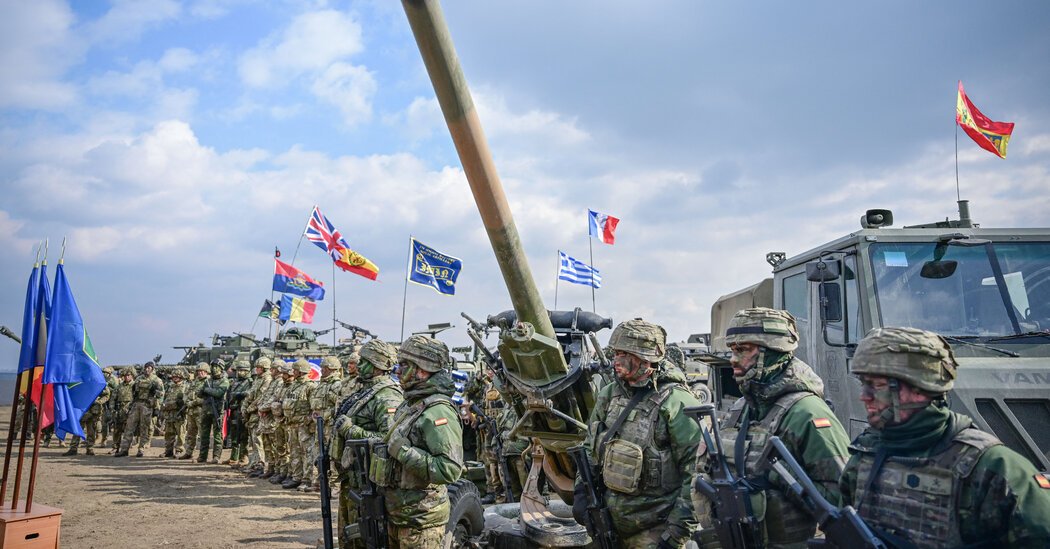President Trump has never had much love for the NATO alliance, which, according to him, is too dependent on the American generosity and, in his first mandate, spoke of the abandonment of the collective defense pact.
In his second mandate, Trump and his senior officials have clearly indicated that the security of Europe is no longer the first priority of the United States, which wants to concentrate resources at its own border and Indo-Pacific, where China has become a counterpart.
Trump on Thursday suggested that The United States may not protect NATO members who believed did not pay enough for their own defense, calling it “common sense”.
But what should Europeans do to replace the huge American contribution to NATO?
The response comes back to money, staff, time and cooperation with Washington, said Ivo Daalder, former US NATO ambassador and co-author of A recent report From the Harvard Belfer Center on how to create “a strong European pillar” in the Alliance.
The central problem is that NATO has been built as an alliance dominated by the Americans, intentionally dependent on American leadership, sophisticated weapons, intelligence and air transport. The current NATO command structure is mainly owned and operated by the United States, led by General Christopher G. Cavoli.
“The United States is the online pin of the alliance so that we can control our allies and have them do what we want,” said Daalder. More practically, the American army is the skeleton of NATO and “if you suddenly remove the skeleton, the body dies”.
Money
Compared to other challenges, money is the easiest part of the European dilemma. The question, like never, is the political will and the commitment to pass more significant sums – and the compromises and the political costs that this will result in.
Prime Minister Donald Tusk of Poland simply said it last week, saying: “500 million Europeans ask 300 million Americans to protect them from 140 million Russians.” What is missing in Europe, he said is “the conviction that we are really a world force”.
Friedrich Merz, who should be the next Chancellor of Germany, has offered a daring response this week to new pressures on Europe, offering to spend nearly 1 Billion of euros, or 1.07 dollars, on the army and infrastructure over the next 10 years.
Great Britain, Belgium, Poland and Denmark have also recently declared that they would spend more. EU leaders agreed to stimulate military spending outside the normal debt limits on Thursday. But overall, European nations remain timid spending that experts say they will have to replace the American commitment.
These estimates vary, but could mean an increase of 250 billion euros per year, or approximately 1.5% of the gross domestic product of the European Union, according to a study From two research institutions, Bruegel and the Kiel Institute for the World Economy.
The study recommends that European nations spend at least 3.5% of GDP per year on the army; Currently, only five of the 32 NATO members, including the United States, spend more than 3%.
Europeans have a lot, but also need much more sophisticated weapons, which is now largely provided by the United States. The biggest gaps concern integrated defense and anti -missile defense and long -term precision strike capacity, said Ben Hodges, a former American army commander in Europe.
Europe also lacks “strategic catalysts”, including transport aircraft, sophisticated drones and satellites – crucial systems for intelligence, surveillance and recognition.
He has the ability to produce more of his own weapons, he said. But that would require better coordination between nations to invest in the right industries and buy jointly.
Ideally, Europe should have enough stocks of ammunition and missiles to fight against a high intensity war for at least six months, but these are seriously exhausted by the war in Ukraine.
A study By the International Institute for Strategic Studies, revealed that even fundamentals such as the number of combat battalions and battle tanks in service have remained static or fallen since 2014, despite the annexation of Crimea by Russia.
The political will is also important here – to overcome bureaucratic constraints and requirements on manufacturers.
The European Investment Bank is prohibited from providing loans to make weapons, although the European Union rethink the rule.
And German law requires that weapon manufacturers have direct government orders before production can even begin. This makes potential future sales impossible, even if they now have an excess capacity.
Staff
Currently, there are only about 100,000 American soldiers in Europe – a number that could be integrated into the University of Michigan football stadium – said Hodges, who commanded them.
However, it seems almost impossible that Europeans, even if they increase military spending, could quickly replace their major part, and even less fight alone for any prolonged period.
On American troops, 20,000 were sent to Europe after Russia invaded Ukraine three years ago to consolidate NATO’s deterrence. Analysts expect the Trump administration to remove these troops for too long.
The other 40,000 other American troops said Hodges, are in Europe on expensive rotations, that Trump is also likely to want to stop.
There are several problems for Europe to replace these numbers.
Only a handful of European nations still have conscription forces. And attracting good recruits is difficult; The remuneration scales and career prospects are better in the civilian world. Even once soldiers are formed, especially in high -tech or “back office” war jobs such as engineering or mechanics, it is difficult to keep them.
Recent suggestions that Europeans put the troops in Ukraine to conclude a potential peace agreement would put additional pressure on the staff, potentially in the long term.
NATO is already pressure on members to meet the requirements of a new model of strength. Under this agreement, more than 300,000 soldiers should be available within 30 days To strengthen the eastern flank of the Alliance against Russia in the event of a crisis.
For the moment, there are simply not enough soldiers, logistics specialists and intelligence officers to go around.
“The European armies are too small to manage even their arms they have now,” said Jim Townsend, a former American defense secretary who is now at the Center for a New American Security.
“The British and the Danes, to choose two examples, are good soldiers, but they would not be able to maintain an intense fight for more than a few weeks,” he said. “No matter how good you are if there are enough you.”
Time
The magnitude of what Americans now manages for NATO is too large to replace quickly. Buy or produce the necessary equipment and recruit and train the necessary troops will simply take time.
In normal times, it would take a decade to Europe to catch up, said Camille Grand, a former assistant secretary of NATO, who wrote A detailed report On the problem of the European Council on foreign relations last year.
Today’s accelerated sense of urgency could help Europeans do it a little earlier. But criticism argues that Europe has waited too long to respond to the clear signaling of Mr. Trump’s first presidency, not to mention his friendly comments from Russia during the campaign.
US officials from both parties have urged European allies to do more for their own defense for 50 years, and President Emmanuel Macron in France Warnings in 2019 About the discoloration of American commitment to NATO has been heard but widely ignored.
Europeans finally try to solve the problem of money. But they cannot make the time required as if necessary to make a transition from American domination of NATO in a way that did not damage their security enough to try Russia to test the alliance.
More importantly, the United States should help the transition and synchronize its withdrawals with European accumulation.
Cooperation
Going from a conventional defense to Europe from Europe to a European defense could be very dangerous without American cooperation.
A sudden American withdrawal would be extremely tempting for President Vladimir V. Putin of Russia, who wants to undermine NATO. The United States must be willing to wait to withdraw key capacities until Europeans are ready to take them back, said Daalder.
Even in Ukraine, with its 900,000 soldiers helping to pin the Russian army, a European commitment of 30,000 to 40,000 peacekeeping soldiers could compromise NATO’s ability to dissuade Russia from testing the Alliance in the Balts, for example.
This has led some experts to suggest that a European force in Ukraine should be a NATO force, without the American troops on the ground, which Mr. Trump has in any case excluded. But NATO force could at least use existing NATO assets, such as surveillance plans and intelligence capacities, within the NATO command structure.
Others, like Max Bergmann of the Center for Strategic and International Studies, think that it is time to review the concept of a European army, which had long opposed the United States.
A unified army, he suggests, would greatly contribute to completing duplication and making spending more effective. But who would command such an army and under what political authority, are difficult questions to answer.
A permanent European army, he argues, does not need to replace the United States with each title but could be integrated into NATO and be robust enough to do its main job: dissuading Russia from invigorating the Member States.
After all, he notes: “Europe on paper has nearly 2 million staff members in uniform and spends about $ 338 billion a year in defense, more than enough to dissuade Russia and enough to make Europe collectively military power.”






